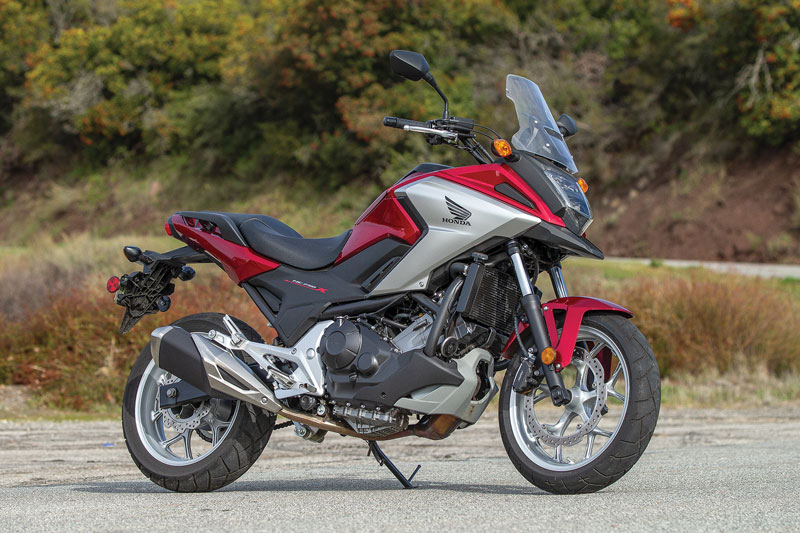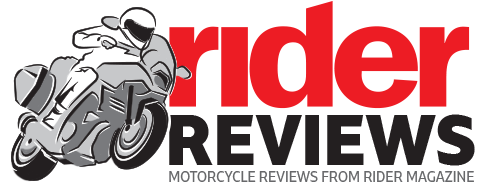2018 Honda NC750X

Road Test Review
I’m just going to come right out and say it: Honda’s NC750X is the best commuter bike out there right now. Don’t worry, I’m wearing my flame-retardant suit and a fire extinguisher is standing by. But I can also back up my bold claim, if you’ll bear with me.
When the original NC700X debuted in 2012, we proclaimed it “the bike many of you have been asking for…and more” (Rider, November 2012 and here). Base price was just $6,999, with the (then) newfangled DCT automatic ABS version coming in at $8,999, and it checked all the boxes: excellent fuel economy, accessible size, appealing ADV styling, comfortable seating, surprisingly decent handling and a locking storage compartment large enough to hold a full-face helmet.
In 2014 the European market got a revised model, its 670cc parallel twin bored out to 745cc and dubbed the NC750X…but here in the States we were stuck with the 700 until last year, when Honda finally dropped it in favor of the 750.
So now we have the NC750X, which has matured into its role as a class-bending, do-it-all machine that hits the sweet spot in terms of price, functionality, style and fun. Base price is now $7,999 for the six-speed manual with LED head- and taillights and colorful LCD instrument, with the DCT ABS model, now featuring Honda Selectable Torque Control (HSTC, a.k.a. traction control), priced at $8,699.
Honda has nearly perfected its three-mode (Drive, Sport and manual) DCT dual-clutch automatic transmission, and honestly for just $700 and roughly 30 extra pounds the DCT model is the way to go, especially since it’s the only way to get the HSTC and combined ABS, which applies front brake when the rear is applied as well as preventing lock-up. But EIC Tuttle must think I’m tough, so a base model, bone stock 2018 NC750X is what I tested, logging more than 1,400 commuting, canyon carving and errand-running miles.
On paper the NC750X is nearly identical to its predecessor, with the primary difference being the squarer bore and stroke (77 x 80mm vs. 73 x 80), which adds a few ponies and ups the rev ceiling to 7,500. The liquid-cooled, dual-counterbalanced, 270-degree, SOHC parallel twin cranks out power well into the midrange. Not to say it’ll ripple the blacktop on a holeshot, but it’s enough for a one-up rider to stay interested on a weekend fling through the twisties, and despite a surprisingly aggressive snarl it pulses pleasantly with no buzzy vibes. It’s also impressively fuel-efficient. On a mixture of high-speed (read: 75-80 mph) freeways and surface streets, I averaged nearly 69 mpg over 1,400 miles, meaning I was filling up the 3.7-gallon tank with regular every 250 miles or so.
The other major upgrade is the two-level HSTC, available only on the DCT ABS model, that allows the rider to choose between low intervention that allows some rear wheel spin (on gravel or dirt, for example) or high intervention for slippery roads. On our test bike my hands and right foot substituted for traction control and ABS, and fortunately the NC750X is easy and forgiving to ride.
That “just enough” power (51 peak horsepower at 6,200 rpm and 48 lb-ft of torque at 4,700 per the Jett Tuning dyno) never feels out of control and throttle response is smooth. A single 320mm wave-style front brake disc necessitates “combined” braking during anything resembling sporty riding, but I’m in the habit of using both front and rear anyway and found brake performance to be more than adequate for my one-up riding habits. As an added bonus, the front brake lever is now adjustable!
Now take a few steps back; at 478 pounds ready to ride the NC750X is essentially a three-quarter-size ADV bike, and this is a major component of its class-bending capabilities. The rider is perched on a 32.7-inch seat, which is comfortable enough for long commutes or day rides, narrow enough for 29-inch-inseam legs to reach the ground and high enough to allow an excellent view of traffic. Reach to the handlebar is also comfortable, and it’s not so wide as to require a yoga pose for full-lock turns. The windscreen does a good job of deflecting air and the LCD instrument is easy to read even in direct sunlight.
Handling potholes, railroad tracks and other pavement irregularities are a 41mm non-adjustable fork with 5.4 inches of travel, and a Pro-Link rear shock with spanner-adjustable preload and 5.9 inches of travel. For just about any type of “normal” riding, including gravel roads and tackling the twisties, I found the suspension to be surprisingly good; it only felt out of sorts when hitting hard bumps while leaned over in a turn.
Lastly, while it’s easy for us grizzled gearheads to become jaded about styling, I must mention that my NC750X tester received numerous compliments from strangers, including one sportbike rider at my gym and a car full of young people who cruised slowly past and called out, “Rad bike!” I’ll admit, it felt good!
Speaking of styling, other testers have complained about having to remove luggage like a tail bag to use the NC’s unorthodox fuel filler under the passenger seat, but there’s an upside: a waterproof 22-liter locking front trunk (endearingly known as the “frunk”), so as a commuter/errand-runner I never found it to be an issue.
Not only does the frunk hold a full-face helmet, I managed to stuff all manner of–well, stuff–in there. Groceries, a gym bag, my 13-inch laptop in a protective sleeve, extra gloves and layers, a combination of the above…you’d be surprised at what you can shove inside. And if you really need more space or want to go touring, Honda sells accessory hard saddlebags and a rear trunk. I only wish my tester’s frunk was fitted with the optional 12V accessory outlet.
Going back to our original 2012 review, I think we can amend our statement to say the updated NC750X is the motorcycle many riders–and soon-to-be riders—have been waiting for. It’s a bike built for today’s motorcyclist: affordable, fuel efficient, with integrated storage and available DCT/ABS, and ready to do it all, from commuting to canyon carving to touring. And it looks good doing it.
